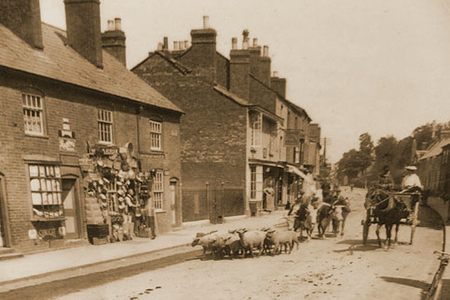The Story of The Seven Stars
The Seven Stars is thought to have been built in the first half of the seventeenth century. The first official record of it is from a 1793 trade directory. Archaeological studies carried out in the 2000s found that the inn was likely to have been built on the site of a former tannery dating back to at least the twelfth century. The building itself underwent several alterations in the following centuries. It overlooked the old open cattle market. Until relatively recently, it had a wooden seat at the door so that customers could watch the cattle sales. There were also stables attached to the rear of the inn which were demolished, as they typically were elsewhere, in the 1930s.
The Seven Stars was almost completely destroyed by a blaze in 2001 that endured for 19 hours, which left only the facade standing intact. Much of the current building is the result of careful rebuilding and restoration work in the years since. A priest's hole was found at the top of the building during the restoration work, implying some of its earliest residents were secret Catholics during the Stuart period of persecution. A bake oven was also found in the main chimney. The event and its aftermath are detailed in some of the images of contemporary press clippings.

The restoration work used 70% of the original timbers. It expanded the size of the current restaurant and added en-suite bathrooms to the three guest rooms, the current kitchen, and disabled access.
Ledbury itself has changed little since Masefield wrote of it as "pleasant to the sight, fair and half-timbered houses, black-and-white". The ancient October Hiring Fair is still held in the streets. Also known as the October Hop Fair, it reflects centuries of tradition whereby hops and fruit are gathered locally for sale. The main street stretches for almost half a mile and is lined with numerous quaint black-and-white half-timbered buildings full of character, many dating from the sixteenth century when the townspeople who worked with cloth and leather enjoyed an era of prosperity.
Information courtesy of The Illustrated Guide to Ledbury (Tilley, 1991) and Ledbury Through Time (Lever, 2013).
Famous ties...
Comfortable and quietly prosperous, Ledbury was much loved by poets. The Brownings and Wordsworth used to visit the town. John Masefield was born here, declaring that Ledbury and its surrounding county had a profound influence on his work.
Many believe that the pub called 'The Lion' in John Masefield's poem The Everlasting Mercy was actually The Seven Stars as the constellation Leo has seven stars:
It was all dark, but at the turning
The Lion had a window burning.
So in we went and up the stairs,
Treading as still as cats and hares.
The way the stairs creaked made you wonder
If dead men's bones were hidden under.





